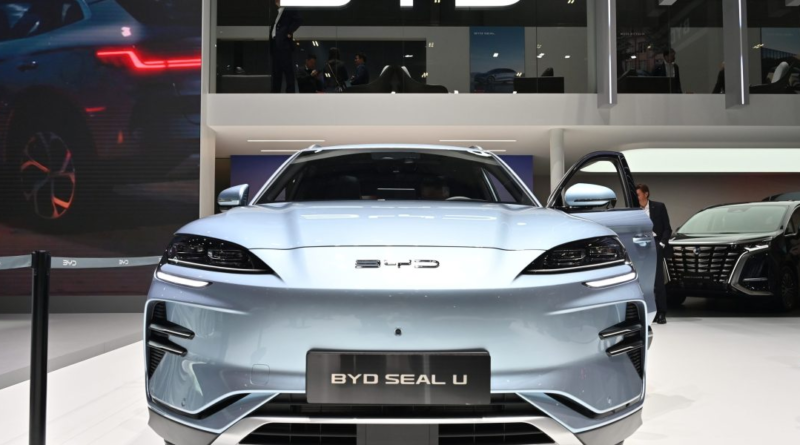Commentary: China may have Asia's most vibrant companies, thanks to green tech, AI and EVs—but don't count the rest of the region out
The world’s an uncertain place. AI is driving executive FOMO, while high geopolitical tension and war is weighing on leaders’ minds. Asia is no exception: While the region has been spared the strong inflation and interest rate hikes seen in the West, economists worry about a property crash in China that could send a shockwave throughout the region.
Billions of people in Asia hope that the now-decades long increase in living standards continues. While economists forecast GDP growth in the mid-single digits, this is by no means certain to manifest itself. And, given the turmoil, it is even harder to judge which companies are set to drive that growth—meaning investors have difficult decisions to make.
To illuminate the matter, Fortune and Boston Consulting Group developed the vitality measure, which quantifies companies’ long-term growth potential. The measure is based on two pillars: A top-down, market-based assessment of a company’s growth potential, and a bottom-up analysis of its capacity to deliver, based on factors like technology, structure, and strategic orientation (read more on our methodology here). This metric underlies the global Future 50 list, which, since its first publication in 2017, has highlighted the most vital public companies around the world each year.
Complementing our global analysis, we are now creating, for the first time, a regional deep dive: the Asia Future 30. This list chronicles the Asian players with the greatest potential for growth and innovation. We decided to spotlight the top 20 most vital Chinese players in the Asia Future 30—and to include the top ten most vital firms from other countries around Asia, highlighting hot spots of growth potential across the region.
So where do we see innovation in Asia? What’s driving it? And what are the challenges that must be navigated to turn potential into reality?
The 3 key trends driving China’s growth potential
China has long been a stronghold of global growth potential. Thirty percent of the Future 50 firms hail from the country.
A look at the Chinese players among the Asia Future 30 reveals that their innovative potential is driven by three trends.
First, green tech players—in particular, solar panel and battery manufacturers—have a strong presence on the list, thanks to government support in the form of subsidies and ambitious renewable energy targets, access to crucial raw materials, and the world’s desire to decarbonize fast.
Second, early movers on AI are poised for future growth. Software companies like Beijing Kingsoft, Hundsun, and JD Health are already rolling out generative AI-based solutions to unlock new revenue sources. And it’s not just digital companies: EV makers like Li Auto and NIO are aggressively investing into advanced driver-assistance systems.
Third, the Chinese companies on the list have global ambitions. Now the world’s largest EV manufacturer, BYD still sells 90% of its cars in China, but is investing heavily in overseas markets to change this. And PDD Holdings—not on the Asia Future 30 due to its Dublin headquarters, but a Chinese-born firm nevertheless—is reported to have spent more than $3 billion on online customer acquisition in the U.S. alone for its new marketplace Temu.
But there are significant risks for Chinese players, and Chinese lawmakers, to navigate.
The property crisis still threatens to dampen consumption and drag down key sectors of the economy.
U.S.-China tensions also remain elevated, due to the situation across the Taiwan straits, the upcoming U.S. election in November, and tight export controls on sales of advanced semiconductors to China.
Finally, the United Nations projects that China will be the oldest country in the world before the year 2100—and its population decline has already begun. As the labor force shrinks, both China’s government and private sector will face the hard task of creating a flourishing aging society.
Hot spots of growth around Asia
The Asia Future 30 list includes ten companies outside of China. Four of them are located in South Korea, hailing from the industrial and communication services sectors. They include POSCO Future M, a manufacturer of battery components, as well as tech giants NAVER and Kakao, which are expanding their portfolios to more lucrative areas like livestreaming, advertising and fintech.
Korean companies are capitalizing on the country’s growing middle-class and rapid experimental product development. The country is responsible for numerous global trends, like K-pop and K-beauty.
India and Japan both send two companies each to the Asia Future 30, reflecting the latent potential in both these economies to innovate.
Yet all Asian countries face the same risk: They all depend, to some extent, on a strong Chinese economy. Individual economies also face unique challenges: Japan and South Korea already have some of the oldest populations in the world. India, on the other hand, needs to preserve stability as it rapidly grows—as well as continually re-skill a vast population as it looks to ascend the economic value chain through export-led growth.
What’s next for Asia Future 30 companies?
A retrospective analysis shows that the companies on the Asia Future 30 list significantly outperformed their peers on revenue growth. These players achieved an average compound annual growth rate of 51% on revenue from H1/2020 to H1/2023, whereas the 500 largest firms on the S&P Pan Asia BMI achieved 6% growth on average. Past performance is no guarantee of future success—yet Asia Future 30 firms are positioned for value-creating growth.
If Asia Future 30 companies want to keep their impressive momentum, they need to make sure they stay at the forefront of new technologies. And governments play a role too, in helping these companies navigate significant macroeconomic and geopolitical headwinds.
After all, new companies are always on the rise. The Asia Future 30 companies focuses on public firms, but excitement is also brewing in the IPO market, with big names set to go public in 2024: fast fashion platform Shein, logistics network Cainiao, and EV scooter firm Ola Electric. They may shake up a hypothetical next edition of the Asia Future 30.
Fang Ruan is a managing director and senior partner and BCG and co-chair of BCG Henderson Institute in China. Ketil Gjerstad is a managing director and senior partner at BCG and leads the firm’s strategy practice. Johann Harnoss is a partner and associate director at BCG and a fellow of the BCG Henderson Institute. Martin Reeves is a managing director and senior partner at BCG and chairman of the BCG Henderson Institute. Adam Job is a director at the BCG Henderson Institute. BCG is a partner with Fortune on the Asia Future 30 list.
Fortune is hosting the inaugural Fortune Innovation Forum in Hong Kong on March 27–28. Experts, investors, and leaders of the world’s largest companies will come together to discuss “New Strategies for Growth,” or how companies can best seize opportunities in a fast-changing world.
The opinions expressed in Fortune.com commentary pieces are solely the views of their authors and do not necessarily reflect the opinions and beliefs of Fortune.



